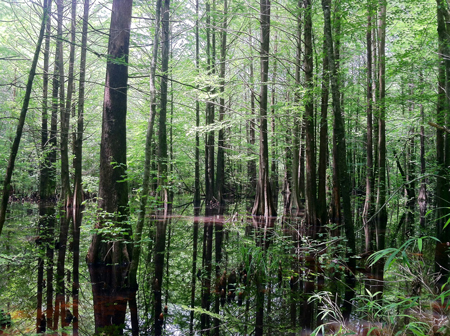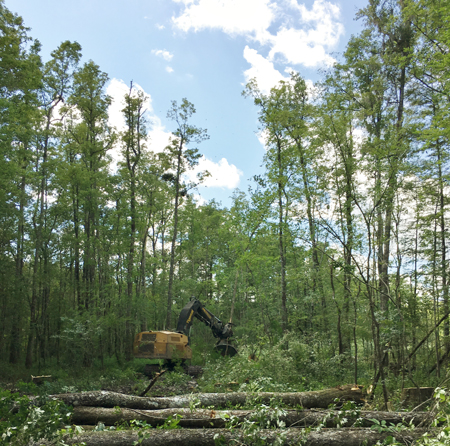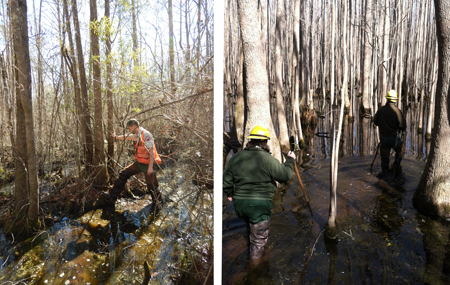Bottomland and Swamp Forests
Bottomland and swamp forests occur in wet-natured environments across the landscape, such as:
- Along the margins of rivers and streams that only get wet during flooding.
- Low flat areas that are continually wet and have deep mucky soils.
- Isolated depressions that retain water for a portion of the year.
The common feature among all of them is the presence of water above or near the ground surface for extended periods. The tree species frequently found in bottomland swamps are adapted to grow in wet soils that have low oxygen levels.
Bottomland swamps are estimated to comprise about 13% of North Carolina’s 18.8 million acres of forests. While they only cover a relatively small amount of area in the state, bottomland swamp forests provide many benefits:
- Protecting water quality
- Mitigating flood impacts
- Unique wildlife habitat
- Renewable forest products
- Recreational opportunities

Much of North Carolina’s bottomland swamp forests were cutover in the 1800s through the mid-1900s. Because of that original harvest timeframe, many swamp forests are now once-again reaching an age and growth cycle that makes the harvesting of that timber economically viable. It is important to note that most of the forests in North Carolina, and the southern U.S., are privately owned. These woodland owners often rely upon their forest as a once-in-a-generation investment that eventually will help to finance important family milestones, such as college education, retirement, or an endowment for heirs.
Today, timber harvesting is governed by rules to protect water quality. While clearcutting is still an important harvesting method, buffers must be retained alongside streams and erosion control measures are required to minimize sedimentation.

Regenerating and managing a bottomland swamp forest involves pre-planning, careful implementation of low-impact harvesting methods, and follow-up monitoring. Historically, many swamps were left alone after logging to re-grow from stump sprouts (foresters call it "coppice"). This method still can be successful if the upstream and downstream hydrology for the site remains un-changed before, during and after the harvest for some time. Recent observations have shown that taking supplemental actions to stimulate regeneration may be needed, and a woodland owner should not rely just on coppice growth when the site's hydrology has been altered. Some examples of these actions include retaining scattered clumps of permanent seed-source trees, or planting seedlings (including live-staking or stick-planting) after a harvest.
A series of NCFS Forestry Leaflets on Bottomland Swamp Forests serve as a quick-reference guide for woodland owners and foresters:
- BF-1: Understanding North Carolina’s Bottomland Swamp Forests
- BF-2: Natural Regeneration in Cypress-Tupelo Swamps
- BF-3: Planting Cypress and Tupelo Seedlings for Reforestation in Deep Swamps
- BF-4: Harvesting Timber Using the Shovel-Mat Logging Method
- BF-5: Understanding Turbidity as it Relates to Logging in Swamps and Bottomland Areas

Over the past few years, the N.C. Forest Service has partnered with the USDA-Forest Service, NCSU Extension Forestry Department, and other cooperators to look into bottomland swamp forest regeneration, growth, harvesting, and overall management. So far, this partnership has resulted in the following:
- A new series of Forestry Leaflets, listed above.
- A bibliography of online references related to bottomland swamp forest regeneration and silviculture in the southeastern U.S.
- Slye, J.N., A.J. Lang, and T.A. Gerow, Jr. 2020. A limited rapid assessment of forest regeneration in 24 cypress and tupelo bottomland swamps following clearcutting and shovel logging in the coastal plain of North Carolina. Forests. 1-17, doi:10.3390/f11080854.
- Demonstration harvests at Bladen Lakes State Forest were implemented to assess methods to re-grow certain desirable tree species in bottomland areas while improving bird habitat.
- A 2-day Bottomland and Swamp Forest Symposium was held in Wilmington, NC in 2017. The presentations from that Symposium are provided below.
Archive of the 2017 NC Bottomland and Swamp Forest Symposium
*DISCLAIMER* The information, opinions, recommendations and conclusions found in the Symposium’s presentations are solely those of the presentation’s author and do not necessarily reflect the views or policies of the N.C. Forest Service, the N.C. Department of Agriculture and Consumer Services, the USDA-Forest Service, nor the NCSU Extension Forestry Department. This Symposium was intended to assemble a diverse range of participants to discuss bottomland swamp forests from multiple viewpoints. These talks are provided here to help landowners and forestry practitioners make more-informed decisions, and to serve as a publicly-accessible archive of this 2017 Symposium.

Conference Agenda and Program Booklet
Panel Speakers: Forest Management Challenges in Bottomlands and Swamps of the South:
Florida and Cypress: (Jeff Vowell)
Georgia and Regulatory Oversight: (John Colberg)
North Carolina and Bottomland Hardwoods: (Jim Slye)
Current Policy Discussions and Partnership Efforts in Bottomland Forests. (Tim Foley)
History of Bottomland Hardwood Research in the South. (Bob Kellison)
USDA-Forest Service Center for Bottomland Hardwood Research. (Emile Gardiner)
Water Quality Regulatory Issues Affecting Wetlands. (Tom Gerow)
Ancient Taxodium Natural History and Dendroclimatology. (David Stahle)
November 1, 2017 Presentations
FIA Data and Extent of the Resource. (Mark Brown)
Ecology of Bottomland Swamp Hardwoods. (Emile Gardiner)
Effects of Timber Harvesting on Cypress and Tupelo Regeneration. (Mike Aust)
Bottomland Swamp Forest Restoration and Artificial Regeneration. (William Conner)
A Survey of 25 Swamp Forest Harvests in the NC Coastal Plain. (Jim Slye)
Ancient Bald Cypress in the Black River of NC. (David Stahle)
Panel Speakers: Looking at Bottomlands from Different Perspectives:
Forest Industry, Enviva. (Ben Larson) [no slideshow presentation]
Conservation, The Nature Conservancy. (Jeff Marcus)
Forest Industry, Meherrin Forest Products. (Don Bright)
Conservation, Audubon. (Curtis Smalling)
Private Landowner. (Hardy Parker) [no slideshow presentation]
Ecological Forestry Practices for Bottomland Forests of the Southeastern US. (Amanda Mahaffey)
Economic and Ecological Values of Bottomland and Swamp Hardwoods. (Fred Cubbage)
November 2, 2017 Field Tour
*DISCLAIMER*: Some field tour sites were located on private property. The tour in 2017 was arranged with landowner permission. Do not attempt to access those properties.